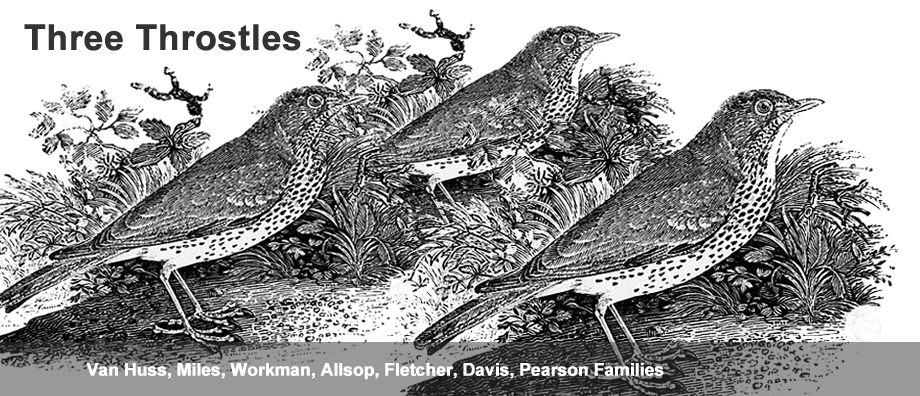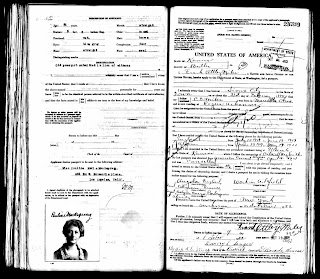[The census records of 1880 and 1900 suggest that Charles and Fannie had only one other child, a daughter named Hattie, born 1879. But in the 1910 census the name "Elsie Duree," daughter , divorced, appears with two grandchildren. The census records that Fannie had three living children, a fourth was deceased.]
Frank Ottley Miles is my wife's grandfather and father to Mary Van Huss, Charlie Miles and Joan Smith. By trade he was an oil rig builder. In the 1920's he traveled to French Algeria where he met and wed Maria Llabres. His travels also included trips to Angola, French West Africa, and the Belgian Congo.
1880 - Dakota Territory
In 1880, before Frank was born, Charles and Fannie Miles homesteaded in the Dakota territory. Their farm was located in Virginia Township of Union County. On Google maps, it is an are of large farms and few towns. One gets there by traveling north from Omaha to Sioux City, Iowa. From there it is 40 miles north along I-29, following the Missouri river past Junction city until coming to Highway 48, where you swing east and travel about 10 miles.
In 1880, Charles and Fannie would have traveled over trails that rambled over the flat fertile prairie. Travel, then, was by horse and wagon, the dirt roads interrupted by streams that had to be crossed at points that could be forded. This was before the railroads and towns, just wide open prairie and a chance to start fresh.
The timing for 27 year old Charles, 23 year old Fannie, and one year old Hattie couldn't have been worse. They were greeted by the Hard Winter of 1880-1881. From October of 1880 through the late spring of 1881, snow fell in unprecedented amounts and when spring finally arrived and the sun shone, the snow melted turning the prairie into a giant lake. It was not an auspicious start for the young family.
History of Spink County, South Dakota
On October 15, 1880 I was in the town of Eden in Union County. On the morning of that day I started to take an all day drive in the county on business. The morning was mild and gave no indication of a storm coming, but it began to be cloudy in the middle of the forenoon. At noon I stopped at a farm about fifteen miles out from town, had the horses fed and took dinner with the farmer. During the dinner hour moist snow began to fall but did not seem threatening. I was in a quandry whether to go further in the country and finish the work office day or to return to town, but finally decided to return and it was well that I did so. The snowfall increased rapidly and became blinding. In the last two miles before reaching town I could hardly see the road or the horses, but I arrived safely about three o'clock in the afternoon. The storm went on and we guests in the over-crowded hotel were confined under the roof for three days.
This terrible winter was followed by economic hardship struck in the early 1880's. Increased farming brought lower wheat prices, then there was a severe drought.
How long the Miles family stuck it out on the prairie is not known. Frank Ottley Miles is born in 1884 in Sioux City, Iowa, but there is no explanation for the location.
The 1890 US census was destroyed in a fire and we take up the family again in 1900.
1900 - Payne County, Stillwater Oklahoma
Until the 20th century, Oklahoma was Indian territory, a place where the US government forceably removed eastern tribes. Ever increasing demand for free and cheap land finally put even Oklahoma up for grabs by Americans of European descent. After 1887 and the Dawes Act, Okla homa was up for grabs. Early settlers in Oklahoma became known as Sooners, the nickname of the state.
The 1900 US Census records that the Miles family, Charles, age 47, Fannie, age 42, and son Frank Miles, age 15, were farming in Stillwater, Payne County, Oklahoma on land which was mortgaged to the bank. Daughter Hattie was now married to Allison Hileman. There is no mention of any other children in the census record, but the census does record that Fannie has four children, three of whom are alive.
Stillwater was created from the Cherokee Outlet. It was part of the first land rush of 1899. The following year, 1900, Stillwater had barely advanced beyond the stage of a tent city. Telephone and gas service was newly established; the Eastern Oklahoma Railroad arrived; and, the population was less than 500. The population of the county at the time of the census totaled 3,536.
Isn't it interesting that Fannie's parents were from New York and she was born in Kansas in the year 1857. Fannie's maiden name is possibly Webster, a fact we learn from the grave registration information for Morrison cemetery in Morrison, Oklahoma where Charles and Fannie Miles are buried along with their daughter Hattie.
1910 - Noble County, Autry Township, Morrison, Oklahoma
By 1910, Charles and Fannie have moved to neighboring Autry Township in Noble County, Oklahoma. Anyone who has driven south from Wichita along I-35 on the way to Oklahoma City will pass through Noble County. Perry is it the largest city in the county. Payne County and Stillwater are to the east.
Note. It is also possible that Charles and Fannie Miles were living in Pawnee County, just over the county line from Noble County, near Morrison.
Now Charles and Fannie are joined by a daughter Elsie Duree, two granddaughters, and Susie Critz, whose relationship is unclear. Frank has moved out of the house. We know that Charles and Fannie had a daughter Hattie who died in 1957. The relationship to Elsie Duree is still unclear.
El Dorado Oil Fields
 |
| El Dorado K |
 |
| Frank Miles 1918 |
Years later after Frank married and returned from Africa, he and his family would settle in Spring Township, Butler County, just off of Haverhill Road. The Stapleton #1 is reached by traveling north on Haverhill to 6th Street.
Passport Application Frank Miles, 1918
Below is the first passport application for Frank O. Miles submitted May 18, 1918. It is barely legible. What can be read is that Frank was born in Sioux City, Iowa on February 21st, 1884. His father was Charles D. Miles of Marietta, Ohio.
Passport Application 1920
Frank applied for and received a second passport in October of 1922. The passport was issued in El Dorado, Kansas on October the 9th. Frank gives his middle name as Ottley. There are also a few more details of his residence - that he resided in England from July 1918 until June 1919, and that he resided in Algeria from June 1919 until May 1922.
We now know that Frank was an Oil Rig Builder,. Back in the 1920's oil rigs were constructed of wood and appeared as so many towers peppering the landscape. He traveled over much of Africa building new rigs. The countries Frank listed included Angola, Portuguese West Africa, and the Belgian Congo.
Add to these few details, that Frank married Maria Llabres in June of 1920. Then, in November of 1925, Frank, his wife Maria, and baby son Charles left Bordeaux for New York aboard the French liner Le Bourdonnais. They settled in Spring Township, Butler County where they remained for the rest of their lives raising their three children Charlie, Joan, and Mary. Maria would remain on the farm with one exception, a trip that she took with her daughter Mary in the late summer of 1954 when she traveled back to France and Algeria to visit relatives.
Spring County then, as it is now, was rural. It is a distance of perhaps 15 miles along Haverhill Road from El Dorado to the township.











